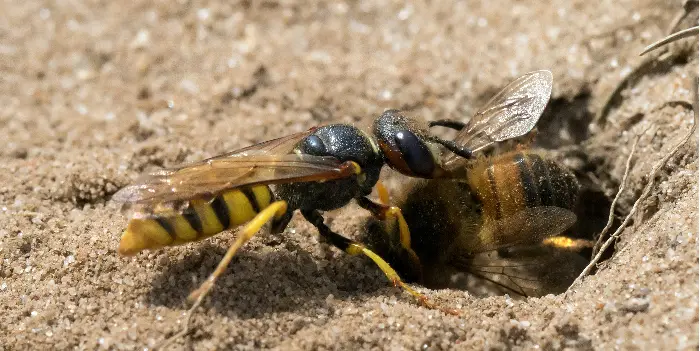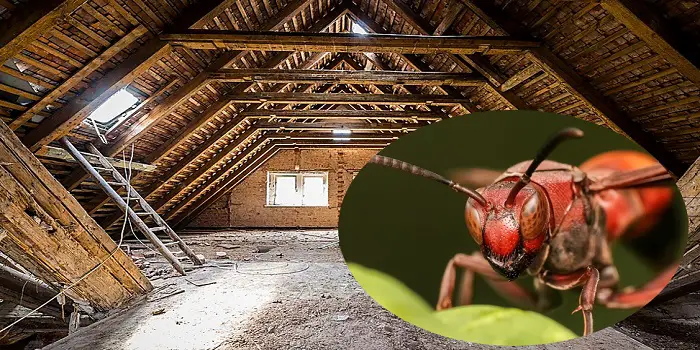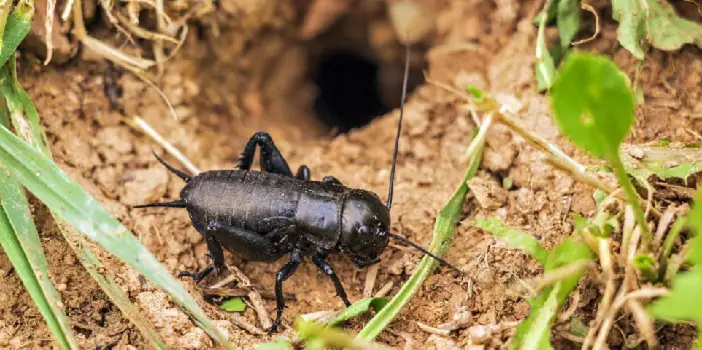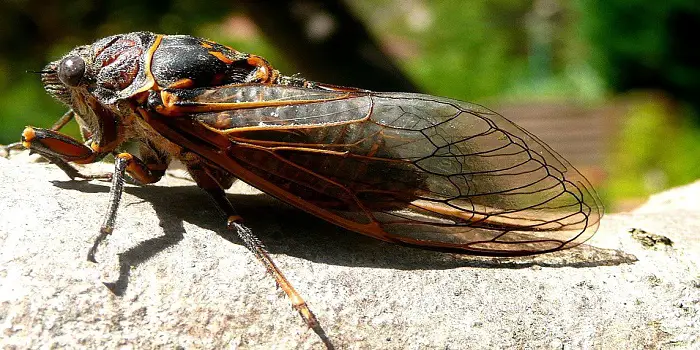
You have probably seen the cicadas in your yard but perhaps have mistaken them for locusts.
Despite the similarities, cicadas are not locusts.
And if you want to keep cicadas off your young trees, different methods are available.
However, it all starts by understanding what cicadas are, the behavior of the cicadas, and knowing the difference between the annual and periodical.
So, let’s start with some basics first…
What are Cicadas?
The cicadas are generally two to three inches long insects that can vary in size depending on the exact species.
They have large eyes that may be black or reddish on each side of their head.
And the most noticeable feature is the clear, large wings.
You should be able to see the veins inside the wings, which helps identify them as cicadas.
The wings develop after the cicadas leave the immature stage in which they are wingless.
Although there are many species of cicadas, they can be broken down into two types which are annual and periodical.
The most common, at least in North America, is annual.
They pop up yearly in the summer, feed, mate, and then go dormant as fall and winter approach.
Periodical cicadas emerge every 13 or 17 years.
Their cycles are so predictable that news and weather stations have created charts that indicate their return.
If the cicadas are active, you will probably see them around your home.
In fact, it is far more likely that you will see their shed skin which retains its basic shape stuck on trees or on the soil.
Why are Cicadas Harmful?
It depends on how you characterize the term “harmful.”
The cicadas do not bite or scratch people, nor do they carry any poison.
In addition, even if several cicadas enter your home, they are unlikely to be any threat in terms of their numbers because they cannot eat nor breed while inside.
This means that you should not fear the infestation of cicadas in your home.
1- They are Extremely Noisy
However, the cicadas are best known for their loud calls that can be quite shrill and repetitive, especially at night.
Hard to believe, but the noise of a cicada can even reach decibels as loud as a motorcycle or a power saw that’s used for woodworking.
A single, signing cicadas can be heard up to a half-mile away, making them the loudest insect in North America.
And since there is rarely just one cicada around, the sound can be quite annoying, especially late at night.
2- Can be Damaging to Plants
Cicadas can prove to be damaging for your small young plants and trees that have fruits on them.
They will generally like to nest on deciduous trees, like elm, ash, chestnut, maple, and oak.
Some of these insects might feed on leaves, while others damage the trees during their egg-laying process.
There are a few cicadas that may also be able to damage the young plants by flagging their branches off.
So, it is little wonder that most people do not want the cicadas to be anywhere near their homes.
How to Protect Young Trees from Cicadas?
For the most part, the trees that need protection from the cicadas are fruit trees along with rose bushes.
They are quite attractive to the cicadas and will need protection.
Although cicadas rarely, if ever eat or consume trees, the sheer weight of their presence on the branches of young trees may damage them.
To keep the cicadas from causing drooping branches, you will need the following…
- Polyolefin Fabric or ¼” Insect Netting
- Zip Ties
- Clothespin, Scissors, Stapler, and Utility Knife
- Tripod Orchard Ladder: If the tree is taller than you can reach.
You can wrap this fabric around the trunk of young trees just below the area where the branches are growing.
If you do not have polyolefin fabric, you can use ¼” netting instead.
Start when you first hear the cicadas begin to sing or just before they are expected to emerge.
- Wrap the open end of the fabric or netting from the bottom to the top of the trunk below the branches
- Be sure to overlap each layer and that it is snug around the trunk.
- Place a zip tie over the fabric or netting and then secure it.
- Depending on the size of the roll, you may need someone else to hold it.
- Clip the unused fabric at the top
- Secure it with a clothespin
- At every overlap point, staple the fabric about every ¼”.
- Once the stapling is complete, remove the clothespin at the top.
Once completed, you should inspect the fabric or netting to ensure that the cicadas cannot enter and harm the tree.
Since most cicadas need about a ½” of space, keeping the spaces more minor than that should be enough to keep them away.
Care must be taken with young trees so you do not bend the branches.
The polyolefin is strong enough to keep the cicadas off the trunks of the trees that they often use to climb up and sit on the branches.
Check it every so often to ensure that the fabric or netting remains strong and repair any damage that might have taken place.
For the dead cicadas you find on the ground, you can till them into the ground until they reach a depth of 8” to 12”.
This will not only provide extra nutrients for your trees or garden it will also help eliminate the odor that comes from the dead cicadas.
Is Cicada Same as Locust or Different?
Cicadas are often confused for locusts, grasshoppers, crickets, katydids, sphinx moths, and June bugs due to their similar shape and appearance.
But they are all different with many different features.
Although you can mistake cicadas for locusts at first glance, the best way to tell them apart is by the loud singing sound that cicadas make while locusts do not.
Male cicadas usually produce this high-pitched droning sound to attract silent female partners for mating.
Cicadas also have a unique life cycle that does not resemble locusts.
| Cicada vs. Locust | Cicada | Locust |
|---|---|---|
| Order | Hemiptera (True Bug) | Orthoptera |
| Family | Cicadoidea | Acrididae |
| Size | 0.75–2.25 in (1.9–5.7 cm) | 0.5–3 in (1.3–7.6 cm) |
| Diet | Tree sap | Leaves and other soft plant tissue |
| Life Span | Up to 17 years | Up to one year |
| Collective Name | Cloud or plague | Swarm |
| Distinguishing Features | Short body, large eyes, clear wings, larger front wings | Long body, larger rear wings, long hind legs |
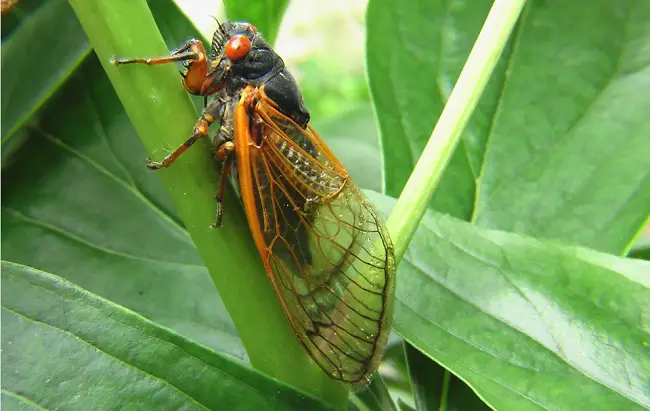
What Can You Do to Make Noisy Cicadas Quiet?
The body structure of a cicada with wings resembles a violin or a guitar which helps in amplifying the loud sound they generate.
This is why their screaming sound can be heard even from far.
In many hot places, cicadas are seen to be the most active during the hottest part of the day.
This is due to the fact that they constantly suck plant sap or liquids and can start sweating in a way that turns them into an evaporative cooler – when it’s too hot.
It’s generally, when the temperature rises above 28°C (82.4°F), cicadas begin to sing their song.
IMO, the chirping and clicking noises of the cicada can be stopped just by disturbing them and making them go off somewhere else.
If you find them sitting on the bush or a plant, you can shake the bush or spray with a garden hose to hit the bugs away.
And also, as I mentioned before, you can keep your young plants and trees protected by a net which will automatically discourage the cicadas from coming and making high-pitched, loud, disturbing noises.
Can You Use Chemicals to Get Rid of Cicadas?
The bad news is that standard chemical treatments which work against most insects are not that effective with cicadas.
This is because the life cycle of the cicadas is relatively short, two to four weeks.
When most chemicals have an effect, the cicadas are already gone.
Only in areas where the cicadas are likely to stay for generation after generation, such as an orchard or plant nursery, are chemicals used.
But there are some simple methods to deal with the cicadas, including the following.
- Picking them by hand
- Spraying water to knock them off plants
- Placing netting to protect valuable plants.
If there are relatively few cicadas, you can pick them up by hand and remove them from your garden.
You can also use your garden hose to spray them off your plants.
However, tree netting for cicadas is quite effective as you still let in the sun, but not the cicadas.
Other Related Questions:
Are cicadas blind?
Cicadas are bulky red-eyed insects. Their eyes look like beads and are not blind.
This means, contrary to popular myth – they can see finely.
These insects are, however, not good at flying due to the design of wings they have.
Should I kill cicada insects?
While it’s tempting to kill cicadas by using pesticides on them, there’s no need to do so because these insects do not bite or sting people.
Also, they are harmless for humans and pets because they do not carry any diseases.
What do cicadas eat and drink?
Unlike many other insects that feed on vegetation, cicadas don’t eat them.
Cicadas usually drink the sap from tree roots, twigs, plants, and soft branches.
The Conclusion
Cicadas and their large swarms may damage plants when they lay eggs in them.
Older woody trees, however, do not face any cicada damage as these insects do not stick around them for long.
Many homeowners also have a problem with cast-off cicada skins that can pile up on their deck, patio, or backyard, especially when the insects are present in huge numbers.
Hopefully, the above tips prove helpful for you to learn ways how to get rid of these insects and stop the damage caused by them.
Share the post "How to Protect Young Trees and Plants from Cicadas?"

Welcome to ProShieldPest.com. I am Tina Jones. I have been working as a pest removal professional in Winslow, Arizona lately. At present, I love to spend my time with my family as a retiree.
Here I share all my knowledge and experiences to help people understand better how they can stop pests at their homes without actually killing them. Hopefully, the information you will find here will help in safeguarding your home! You can check more about me here.


